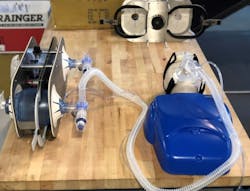According to The Engineer (April 7, 2020), a Bag Valve Mask (BVM) ventilator serves two patients simultaneously with a ‘flat-pack’ design, meaning it can be quickly laser-cut and manufactured at scale at a cost of under £75 ($100) per unit.
The ventilator can be easily adjusted and updated as required, and can be linked to an oxygen generator and positive end expiratory pressure (PEEP) valves and filters. The units derive power from standard wall adapters or 12 V vehicle batteries.
The BVMs are designed to be used by medical staff, first responders, nurses, doctors, and carers as a temporary or emergency breathing aid for those with COVID-19.
The ventilator device works with ‘positive displacement,’ forcing air into the patient’s lungs, a process that has to be controlled to ensure the right amount of air goes in at the right rhythmic pace, or ‘tidal volume.’
The BVM ventilator can ventilate two patients at the same respirator rate, but with independent tidal volume control, or ventilate one patient at twice the respirator rate, allowing for alternating tidal volumes. Cranfield added that the tidal volume control is mechanically set using a bumper and slider, and the respirator rate is set by using a potentiometer connected to a DC motor and gear box.
Professor Leon Williams, head of the Centre for Competitive Creative Design (C4D) at Cranfield University, joined forces with Associate Professor Shannon Yee from the Georgia Institute of Technology (Georgia Tech; Atlanta, GA) to rapidly design and build the low-cost and robust makeshift ventilator.
“We focused on creating something that can be mass-produced using water-jet or laser cutting, and modular in design to make it easy to assemble and switch out parts. Within five days of getting the brief, an initial design from the Cranfield team was sent to Georgia Tech to test,” Professor Williams said.
“We focused on creating something that can be mass-produced using water-jet or laser cutting, and modular in design to make it easy to assemble and switch out parts,” Professor Williams said. “Within five days of getting the brief, an initial design from the Cranfield team was sent to Georgia Tech to test.”
A small batch of the devices has already been assembled for testing. The research team intends to make plans for the device to be available to manufacturers as quickly as possible.
